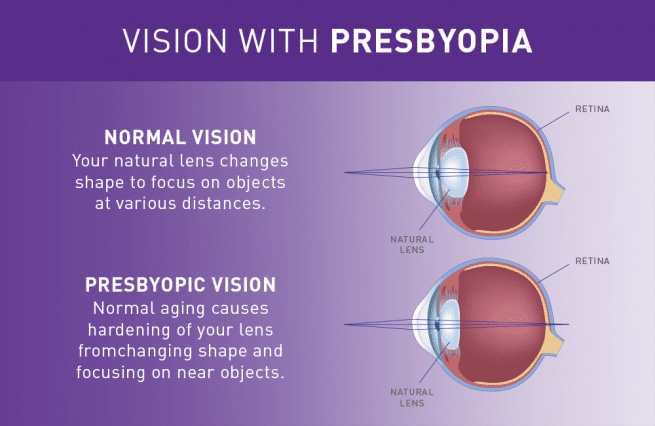Vision Correction Options
Gordon Schanzlin New Vision Institute offers an extensive variety of surgical options for correcting vision problems. By utilizing the latest in world class technologies, our surgeons are capable of fully customizing your treatment plan for optimal results.


Refractive Errors
A refractive error is a vision condition that makes it hard for the retina to properly focus light rays. When the eyes are irregularly shaped, this can cause a problem with the way they are able to bend (refract) rays of light onto the retina, leading to refractive errors such as nearsightedness, farsightedness, astigmatism, and presbyopia. Here at Gordon Schanzlin New Vision Institute, we offer a comprehensive selection of advanced procedures, including laser vision correction such as LASIK and PRK, EVO ICL, and refractive lens exchange (RLE), to improve refractive errors and help you see clearly without heavy reliance on corrective eyewear.
Below, you’ll find descriptions of some of the most common refractive eye conditions. If you would like more information, or if you would like to schedule an eye evaluation with one of our experienced ophthalmologists, please contact us today.
Myopia (Nearsightedness)
When the eye is too long or the cornea too steep, myopia can often result. Commonly known as nearsightedness, this condition causes objects at a far distance to appear blurry, while those at a near distance look perfectly clear.
Hyperopia (Farsightedness)
Hyperopia, or farsightedness, is caused by an irregular curvature of the eye’s cornea. It can also result from the cornea being too short. These conditions can lead to the retina being bypassed while trying to focus light. Ultimately, farsightedness causes distant objects to be seen clearly, while up-close objects appear blurry.
Astigmatism
The eye’s cornea is normally shaped like a sphere; however, a common condition known as astigmatism gives the cornea an uneven form, often resembling the shape of a football. Astigmatism can cause problems focusing on both near and faraway objects, leading to double-vision or blurry vision. While astigmatism was traditionally not treatable with laser vision correction surgery, that is no longer the case. Both LASIK and PRK procedures can effectively treat astigmatism and provide a much clearer view.
Presbyopia
Presbyopia, sometimes referred to as dysfunctional lens syndrome or DLS, is a condition that often affects people over 40. Many individuals begin to lose their ability to clearly see objects at a close distance during this period in life, and often require bifocals or trifocals to read, drive, and engage in other activities. Gordon Schanzlin New Vision Institute offers a range of procedures which can help, including Monovision LASIK/PRK or Refractive Lens Exchange using advanced intraocular lenses.

Vision Correction Options
LASIK
Our LASIK surgeons are able to create a fully custom treatment plan based on selecting the laser technology that offers you the best chance of achieving the optimal result. We perform all-laser LASIK using the most state-of-the-art LASIK technology available. We are also a premier provider of LASIK to the military, and offer special discounts to help our armed service members achieve their best possible vision.
Learn More
Photorefractive Keratectomy (PRK)
PRK is an excellent alternative for patients with thinner corneas or who might not be a candidate for LASIK. Treatment is performed on the surface of the cornea as opposed to under a flap created for LASIK.
Learn More
EVO ICL (Implantable Collamer Lens)
The EVO ICL is an implantable lens made of collamer, a biocompatible material. The ICL can correct high levels of nearsightedness and astigmatism and offers many benefits. It can be an ideal option for patients who are not candidates for LASIK or PRK due to high prescriptions, dry eyes, or thin corneas.
Learn More
Refractive Lens Exchange (RLE)
Refractive Lens Exchange or RLE is a vision correction procedure that uses the same technology as cataract surgery to replace the eye’s natural lens with an advanced intraocular lens (IOL). RLE with a premium IOL can correct a range of vision issues, including presbyopia, making it a good choice for patients over the age of 40.
Learn More
Vision Correction Comparison Chart
Not sure which vision correction surgery option will best meet your unique needs? Take a look at the helpful chart below detailing the differences, benefits and results of our vision correction options and how they compare to each other.
Contact Gordon Schanzlin New Vision Institute
At Gordon Schanzlin New Vision Institute, we are the providers of choice for LASIK and other vision correction services in La Jolla and throughout San Diego. To learn more about your personal vision correction options, please contact us to schedule an appointment with a highly experienced ophthalmologist.
The doctors at Gordon Schanzlin New Vision Institute have either authored or reviewed and approved this content.
Page Updated:

